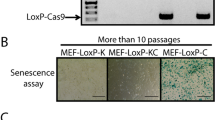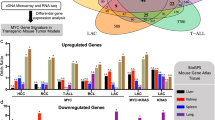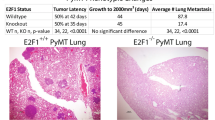Abstract
Progression Elevated Gene-3 (PEG-3) was cloned using subtraction hybridization as an upregulated transcript associated with transformation and tumor progression of rat embryo fibroblast cells. PEG-3 is a unique gene facilitating tumor progression by modulating multiple pathways in transformed cells, including genomic stability, angiogenesis and invasion. PEG-3 originates from mutation in the growth arrest and DNA damage inducible gene GADD34. A one base deletion in rat GADD34 results in a frame-shift and premature appearance of a stop-codon resulting in a C-terminally truncated molecule that is PEG-3. We now document that mutation in the GADD34 gene is a frequent event during transformation and/or immortalization of rodent cells. Sequencing of the GADD34 gene in a number of independent rat tumor cell lines revealed that in a majority of these the GADD34 gene is mutated to either PEG-3 or a PEG-3-like gene with similar C-terminal truncations. An important function of GADD34 is to inhibit cell growth, predominantly by apoptosis, and we demonstrate that PEG-3 or C-terminal truncations of human GADD34 resembling PEG-3 prevent growth inhibition by both human and rat GADD34. Phosphorylation of p53 by GADD34 is one mechanism by which it inhibits growth and PEG-3 could prevent GADD34-induced p53 phosphorylation. In contrast, PEG-3 was unable to block other GADD34-induced changes, including eIF2α dephosphorylation, indicating that its effects on GADD34 may be related more to its effect on cell growth rather than a global inhibitor of all GADD34 functions. We hypothesize that mutational generation of PEG-3 or a similar molecule is a critical event during rodent carcinogenesis. The inherent property of PEG-3 to function as a dominant negative of the growth inhibitory property of GADD34 might rescue cells from DNA damage-induced apoptosis leading to growth independence and tumorigenesis.
This is a preview of subscription content, access via your institution
Access options
Subscribe to this journal
Receive 50 print issues and online access
$259.00 per year
only $5.18 per issue
Buy this article
- Purchase on Springer Link
- Instant access to full article PDF
Prices may be subject to local taxes which are calculated during checkout








Similar content being viewed by others
References
Adler HT, Chinery R, Wu DY, Kussick SJ, Payne JM, Fornace Jr AJ and Tkachuk DC . (1999). Mol. Cell. Biol., 19, 7050–7060.
Babiss LE, Zimmer SG and Fisher PB . (1985). Science, 228, 1099–1101.
Brush MH, Weiser DC and Shenolikar S . (2003). Mol. Cell. Biol., 23, 1292–1303.
Bulavin DV, Saito S, Hollander MC, Sakaguchi K, Anderson CW, Appella E and Fornace Jr AJ . (1999). EMBO J., 18, 6845–6854.
Connor JH, Weiser DC, Li S, Hallenbeck JM and Shenolikar S . (2001). Mol. Cell. Biol., 21, 6841–6850.
Emdad L, Sarkar D, Su Z-Z, Boukerche H, Bar-Eli M and Fisher PB . (2005). J. Cell. Physiol., 202, 135–146.
Fiscella M, Ullrich SJ, Zambrano N, Shields MT, Lin D, Lees-Miller SP, Anderson CW, Mercer WE and Appella E . (1993). Oncogene, 8, 1519–1528.
Fisher PB, Babiss LE, Weinstein IB and Ginsberg HS . (1982). Proc. Natl. Acad. Sci. USA, 79, 3527–3531.
Fisher PB, Weinstein IB, Eisenberg D and Ginsberg HS . (1978). Proc. Natl. Acad. Sci. USA, 75, 2311–2314.
Fornace Jr AJ, Nebert DW, Hollander MC, Luethy JD, Papathanasiou M, Fargnoli J and Holbrook NJ . (1989). Mol. Cell. Biol., 9, 4196–4203.
Grishin AV, Azhipa O, Semenov I and Corey SJ . (2001). Proc. Natl. Acad. Sci. USA, 98, 10172–10177.
Hasegawa T and Isobe K . (1999). Biochim. Biophys. Acta., 1428, 161–168.
Hasegawa T, Xiao H, Hamajima F and Isobe K . (2000a). Biochem. J., 352 (Part 3), 795–800.
Hasegawa T, Yagi A and Isobe K . (2000b). Biochem. Biophys. Res. Commun., 267, 593–596.
Hinds PW, Finlay CA, Quartin RS, Baker SJ, Fearon ER, Vogelstein B and Levine AJ . (1990). Cell Growth Differ., 1, 571–580.
Hollander MC, Poola-Kella S and Fornace Jr AJ . (2003). Oncogene, 22, 3827–3832.
Hollander MC, Sheikh MS, Yu K, Zhan Q, Iglesias M, Woodworth C and Fornace Jr AJ . (2001). Int. J. Cancer, 96, 22–31.
Hollander MC, Zhan Q, Bae I and Fornace Jr AJ . (1997). J. Biol. Chem., 272, 13731–13737.
Kojima E, Takeuchi A, Haneda M, Yagi A, Hasegawa T, Yamaki K, Takeda K, Akira S, Shimokata K and Isobe K . (2003). FASEB J., 17, 1573–1575.
Lord KA, Hoffman-Liebermann B and Liebermann DA . (1990). Nucleic Acids Res., 18, 2823.
Novoa I, Zeng H, Harding HP and Ron D . (2001). J. Cell Biol., 153, 1011–1022.
Sarkar D, Su Z-Z, Lebedeva IV, Sauane M, Gopalkrishnan RV, Valerie K, Dent P and Fisher PB . (2002). Proc. Natl. Acad. Sci. USA, 99, 10054–10059.
She QB, Bode AM, Ma WY, Chen NY and Dong Z . (2001). Cancer Res., 61, 1604–1610.
She QB, Chen N and Dong Z . (2000). J. Biol. Chem., 275, 20444–20449.
Sherr CJ . (2004). Cell, 116, 235–246.
Sherr CJ and McCormick F . (2002). Cancer Cell, 2, 103–112.
Su Z-Z, Austin VN, Zimmer SG and Fisher PB . (1993). Oncogene, 8, 1211–1219.
Su Z-Z, Goldstein NI, Jiang H, Wang MN, Duigou GJ, Young CSH and Fisher PB . (1999). Proc. Natl. Acad. Sci. USA, 96, 15115–15120.
Su Z-Z, Gopalkrishnan RV, Narayan G, Dent P and Fisher PB . (2002). J. Cell. Physiol., 192, 34–44.
Su Z-Z, Lin J, Grunberger D and Fisher PB . (1994). Cancer Res., 54, 1865–1870.
Su Z-Z, Madireddi MT, Lin JJ, Young CS, Kitada S, Reed JC, Goldstein NI and Fisher PB . (1998). Proc. Natl. Acad. Sci. USA, 95, 14400–14405.
Su Z-Z, Shi Y and Fisher PB . (1997). Proc. Natl. Acad. Sci. USA, 94, 9125–9130.
Takekawa M and Saito H . (1998). Cell, 95, 521–530.
Valerie K . (1999). Biopharmaceutical Drug Design and Development. Humana press: Totowa, NJ, pp. 69–142.
Yagi A, Hasegawa Y, Xiao H, Haneda M, Kojima E, Nishikimi A, Hasegawa T, Shimokata K and Isobe K . (2003). J. Cell Biochem., 90, 1242–1249.
Zhan Q, Lord KA, Alamo Jr I, Hollander MC, Carrier F, Ron D, Kohn KW, Hoffman B, Liebermann DA and Fornace Jr AJ . (1994). Mol. Cell. Biol., 14, 2361–2371.
Acknowledgements
The present research was supported in part by National Institutes of Health Grant CA35675, the Samuel Waxman Cancer Research Foundation and the Chernow Endowment. PBF is the Michael and Stella Chernow Urological Cancer Research Scientist in the Departments of Pathology, Urology and Neurosurgery at Columbia University Medical Center and an SWCRF Investigator.
Author information
Authors and Affiliations
Corresponding author
Rights and permissions
About this article
Cite this article
Su, Zz., Emdad, L., Sarkar, D. et al. Potential molecular mechanism for rodent tumorigenesis: mutational generation of Progression Elevated Gene-3 (PEG-3). Oncogene 24, 2247–2255 (2005). https://doi.org/10.1038/sj.onc.1208420
Received:
Revised:
Accepted:
Published:
Issue Date:
DOI: https://doi.org/10.1038/sj.onc.1208420
Keywords
This article is cited by
-
MRI detection of the malignant transformation of stem cells through reporter gene expression driven by a tumor-specific promoter
Stem Cell Research & Therapy (2021)
-
C-terminal region of GADD34 regulates eIF2α dephosphorylation and cell proliferation in CHO-K1 cells
Cell Stress and Chaperones (2016)
-
Endoplasmic reticulum stress, unfolded protein response and development of colon adenocarcinoma
Virchows Archiv (2016)
-
The endoplasmic reticulum stress marker CHOP predicts survival in malignant mesothelioma
British Journal of Cancer (2013)
-
Tumor-specific imaging through progression elevated gene-3 promoter-driven gene expression
Nature Medicine (2011)



